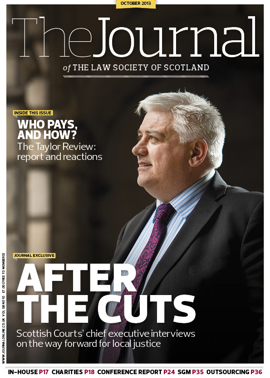President's column

I must confess that I found the arrival of the special general meeting late last month more than a little disturbing, mainly because it heralded both the coming of autumn and – even more alarmingly – the end of the fourth month of my term of office.
Reflecting on that, it occurred to me that it is in some ways similar to a short-haul flight – a huge amount of energy expended taking off and getting up to cruising altitude (which I have now just about reached); then a pulling back on the throttles to maintain a steady speed and course, which also allows for more communication of how the flight is progressing (I’ll be doing this over the coming weeks); followed by a controlled descent and, finally, a safe and timely landing.
Top of the agenda at the SGM was the issue of separate legal representation for borrowers and lenders in conveyancing transactions. Following a thoughtful and wide-ranging debate in a packed-out conference room, members voted against a move to change the conflict of interest rules to introduce mandatory separate representation. And, while the number of votes cast – more than 1,500 with proxies – was encouraging, the result and preceding discussion highlighted the fact that opinion remains both strongly held and relatively evenly divided (56% against and 44% in favour of a rule change). This follows a vote backing the principle of separate representation at the AGM earlier this year, and a consultation exercise in the summer that revealed a near 50-50 split on the issue.
The Society’s Regulatory Committee, which today oversees all changes to our rules and other regulatory business, will now review this complex and sensitive issue, taking into account the result of the vote and the views expressed by members. One aspect of the SGM that will have been well received by everyone was Kennedy Foster, the CML’s longstanding Scottish presence, confirming his enthusiasm for negotiating the updates that are needed to the CML handbook. That was good to hear and will now be taken forward apace.
In other SGM business, members agreed to freeze the practising certificate fee at the same rate for the fourth successive year. And, given the challenges faced by many in the still challenging economic recovery, the intention articulated at the meeting to maintain that subscription level for the next three financial years will have been welcome.
Conference highlights
The challenges facing the profession were the subject of two major events in the past month. Delegates at the flagship Law in Scotland conference that followed the SGM – with its theme of whether legal businesses and the solicitors’ profession faced “evolution or extinction” – heard a range of really thought-provoking speakers, prompting great feedback. I hope to relate the key messages I took away from it next month, if not before. We were joined by colleagues from Ireland and Northern Ireland, which was both good to see and provided some useful perspective.
Before leaving that topic, I would like, briefly, to recognise Sarah Prior and her Update team, who did a great job in staging the event; it did not run so smoothly by accident!
A fortnight before, the annual legal aid conference in Dunblane (held jointly with the Scottish Legal Aid Board) produced a lively exchange of views over a number of issues, including (of course) contracting. As I made clear to delegates, although my mind is certainly not closed to the introduction of contracting, I do not believe a sufficiently robust case has yet been presented to justify such a significant change in the way legal aid in Scotland is delivered.
That conference attracts, year on year, the attendance of the Cabinet Secretary for Justice; that he consistently allocates time in his schedule to do so is much appreciated.
More on this and other aspects of legal aid and access to justice in the weeks and months ahead.
Look out for
During October, the Society will give evidence to the Scottish Parliament’s Justice Committee on the arrest and custody sections of the Criminal Justice Bill, with corroboration to be dealt with later in the year. Then, towards the end of the month, look out for publication of the results of our biggest ever research project on the makeup of the profession. More than 3,500 solicitors responded to our request for feedback into how the profession is structured and works, and how it is changing, across a broad range of criteria. The excellent participation rate allows us to understand our members better, respond to their needs, and also to ensure that our efforts to support as diverse a profession as possible are properly focused. I am sure you will find the results interesting.
Next month’s column will also contain a roundup from the International Bar Association annual conference, which will just have concluded by the time this issue of the Journal hits the streets.
In this issue
- Jewel in the crown, or just red tape?
- In the public interest
- Sweeney: room for manoeuvre
- Lost in translation?
- EU Fundamental Rights Agency: the missing link?
- Reading for pleasure
- Opinion column: Stephen Gold
- Book reviews
- Profile
- President's column
- FM officially opens new MBH
- Feeling the squeeze
- Litigation: a numbers game
- Mythbusting! The in-house IT top ten
- Charities and the changing legal landscape
- Heir finding: the sensitive side
- Sign up to boost charity giving
- Law, but not as we know it
- All the permutations
- The truth, the whole truth...
- Shale gas: a complex process
- Expenses up to date?
- Scottish Solicitors' Discipline Tribunal
- Room at the top?
- Here comes the flood?
- SGM decision kills "sep rep"
- Outsourcing: the straight and narrow
- How not to win business: a guide for professionals
- Properly engaged?
- Ask Ash
- Sep rep: what now?
- From the Brussels office
- Law reform roundup






